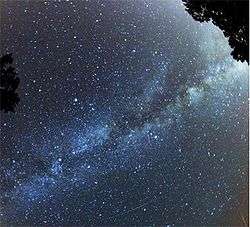Starlight

Starlight is the light emitted by stars.[1] It typically refers to visible electromagnetic radiation from stars other than the Sun observable from Earth during the night time although a component of starlight is observable from the Earth during the daytime.
Sunlight is the term used for the Sun's starlight observed during daytime. During nighttime, albedo describes solar reflections from other Solar System objects including moonlight.
Observation
Observation and measurement of starlight through telescopes is the basis for many fields of astronomy,[2] including photometry and stellar spectroscopy.[3] Hipparchus did not have a telescope or any instrument that could measure apparent brightness accurately, so he simply made estimates with his eyes. He sorted the stars into six brightness categories, which he called magnitudes.[4] He referred to the brightest stars in his catalog as first-magnitudes stars, which were the brightest stars and those so faint he could barely see them were sixth-magnitude stars.[4]
Starlight is also a notable part of personal experience and human culture, impacting a diverse range of pursuits including poetry,[5] astronomy,[2] and military strategy.[6]
The United States Army spent millions of dollars in the 1950s and onward to develop a starlight scope, that could amplify starlight, moonlight filtered by clouds, and the fluorescence of rotting vegetation about 50,000 times to allow a person to see in the night.[6] In contrast to previously developed active infrared system such as sniperscope, it was a passive device and did not require additional light emission to see.[6]
The average color of starlight in the observable universe is a shade of yellowish-white that has been given the name Cosmic Latte.
Starlight spectroscopy, examination of the stellar spectra, was pioneered by Joseph Fraunhofer in 1814.[3] Starlight can be understood to be composed of three main spectra types, continuous spectrum, emission spectrum, and absorption spectrum.[1]
Oldest starlight
One of the oldest stars yet identified (oldest not most distant in this case) was identified in 2014, the star SMSS J031300.362670839.3 was determined to be 6000 light years away but date to 13.8 billion years ago.[7] The starlight shining on Earth would include this star.[7]
Photography
In the field of photography, there is a specialty of night-time photography especially when subjects are lit primarily by starlight.[8] Directly taking images of night sky is also a part of astrophotography.[9] Starlight astrophotography can also be used for the pursuit of science and/or leisure.[10][11] Starlight photography can be important for observing nocturnal animals.[9] In many cases starlight photography may also overlap with a need to understand the impact of moonlight.[9]
See also
References
- 1 2 Keith Robinson – Starlight: An Introduction to Stellar Physics for Amateurs (2009) – Page 38-40 (Google Books Link)
- 1 2 Macpherson, Hector (1911). The romance of modern astronomy. p. 191.
- 1 2 J. B. Hearnshaw – The analysis of starlight: one hundred and fifty years of astronomical spectroscopy (1990) – Page 51 (Google Books link)
- 1 2 Astronomy. https://d3bxy9euw4e147.cloudfront.net/oscms-prodcms/media/documents/Astronomy-Draft-20160817.pdf: Rice University. 2016. p. 761. ISBN 1938168283- via Open Stax.
- ↑ Wells Hawks Skinner – Studies in literature and composition for high schools, normal schools, and ... (1897) – Page 102 (Google eBook link)
- 1 2 3 Popular Mechanics – Jan 1969 – "How the Army Learned to See in the Dark" by Mort Schultz (Google Books link)
- 1 2 "Ancient Star May Be Oldest in Known Universe".
- ↑ Rowell, Tony (2 April 2018). "Sierra Starlight: The Astrophotography of Tony Rowell". Heyday – via Google Books.
- 1 2 3 Ray, Sidney (23 October 2015). "Scientific Photography and Applied Imaging". CRC Press – via Google Books.
- ↑ Ray, Sidney (2015-10-23). Scientific Photography and Applied Imaging. CRC Press. ISBN 9781136094385.
- ↑ Ray, Sidney (2015-10-23). Scientific Photography and Applied Imaging. CRC Press. ISBN 9781136094385.